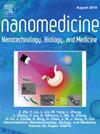脑肽修饰外泌体介导的药物传递系统治疗阿霉素肾病。
IF 4.6
2区 医学
Q2 MEDICINE, RESEARCH & EXPERIMENTAL
Nanomedicine : nanotechnology, biology, and medicine
Pub Date : 2025-03-31
DOI:10.1016/j.nano.2025.102819
引用次数: 0
摘要
缓解阿霉素(ADR)引起的肾病在临床管理中仍然是一个重大挑战。脑靶向给药氯沙坦在1:500浓度下与灌胃给药具有相当的肾保护作用。本研究建立了一种基于外泌体的纳米给药平台(ExoACP),以减少药物剂量,减轻adr引起的肾病。该平台经过了严格的毒性和血脑屏障穿透性测试。此外,我们还探讨了ExoACP-Los在减轻adr引起的小鼠肾病中的作用和可能的机制。ExoACP在脑微血管内皮细胞中的渗透增强,摄取增加7.20倍。在ADR模型中,ExoACP-Los通过下调肾素-血管紧张素系统表现出抗炎和抗纤维化作用,使细胞外基质沉积减少近一半。这些研究结果表明,ExoACP-Los可以通过增强靶向药物向大脑的传递而减少氯沙坦,从而减轻adr诱导的肾病。总的来说,ExoACP在慢性肾病的未来临床应用中具有重要的潜力。本文章由计算机程序翻译,如有差异,请以英文原文为准。

Brain peptides modified exosome-mediated drug delivery system for adriamycin-induced nephropathy treatment
Mitigation of adriamycin (ADR)-induced nephropathy remains a significant challenge in clinical management. Brain-targeted administration of losartan demonstrates comparable nephroprotective effects at a 1:500 concentration relative to gavage administration. This study established an exosome-based nano-delivery platform (ExoACP) to reduce drug dosage for alleviating ADR-induced nephropathy. The platform was rigorously tested for toxicity and blood-brain barrier penetration. Additionally, the role and possible mechanism of ExoACP-Los in alleviating ADR-induced nephropathy in mice were investigated. ExoACP showed enhanced penetration in brain microvascular endothelial cells, with a 7.20-fold increase in uptake. In the ADR model, ExoACP-Los exhibited anti-inflammatory and anti-fibrotic effects by downregulating the renin-angiotensin system, reducing extracellular matrix deposition by nearly half. These findings suggest ExoACP-Los can alleviate ADR-induced nephropathy by enhancing targeted drug delivery to the brain while reducing losartan. Overall, ExoACP holds significant potential for future clinical applications in chronic nephropathy.
求助全文
通过发布文献求助,成功后即可免费获取论文全文。
去求助
来源期刊
CiteScore
11.10
自引率
0.00%
发文量
133
审稿时长
42 days
期刊介绍:
The mission of Nanomedicine: Nanotechnology, Biology, and Medicine (Nanomedicine: NBM) is to promote the emerging interdisciplinary field of nanomedicine.
Nanomedicine: NBM is an international, peer-reviewed journal presenting novel, significant, and interdisciplinary theoretical and experimental results related to nanoscience and nanotechnology in the life and health sciences. Content includes basic, translational, and clinical research addressing diagnosis, treatment, monitoring, prediction, and prevention of diseases.

 求助内容:
求助内容: 应助结果提醒方式:
应助结果提醒方式:


